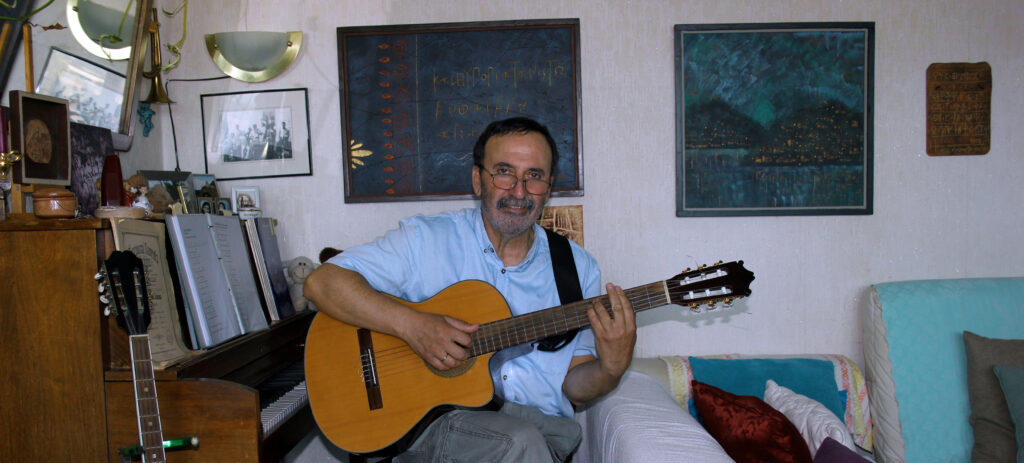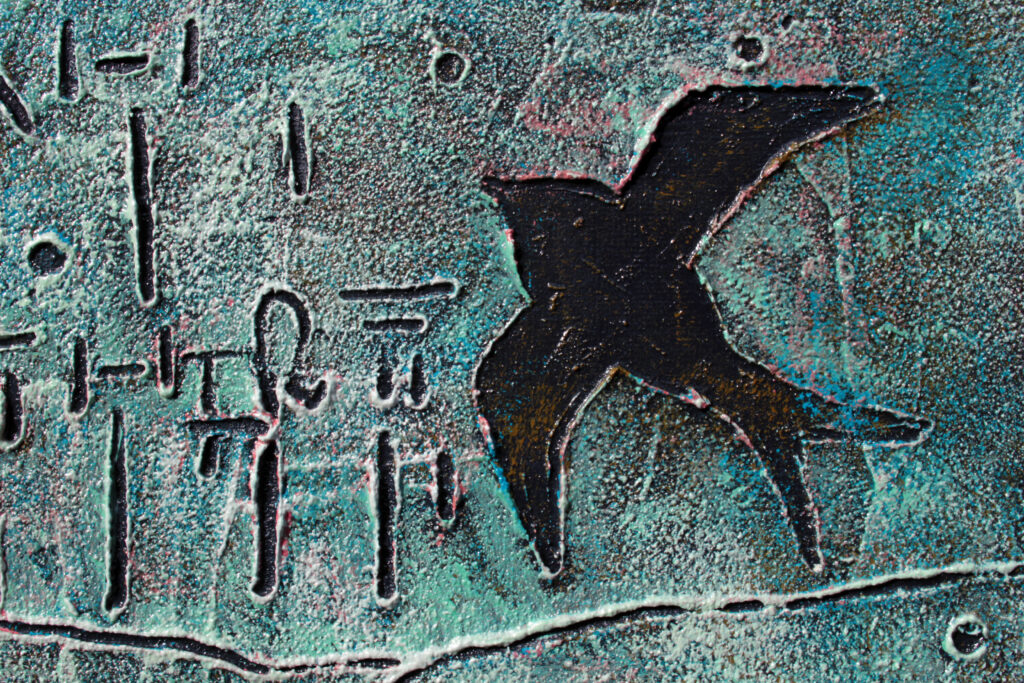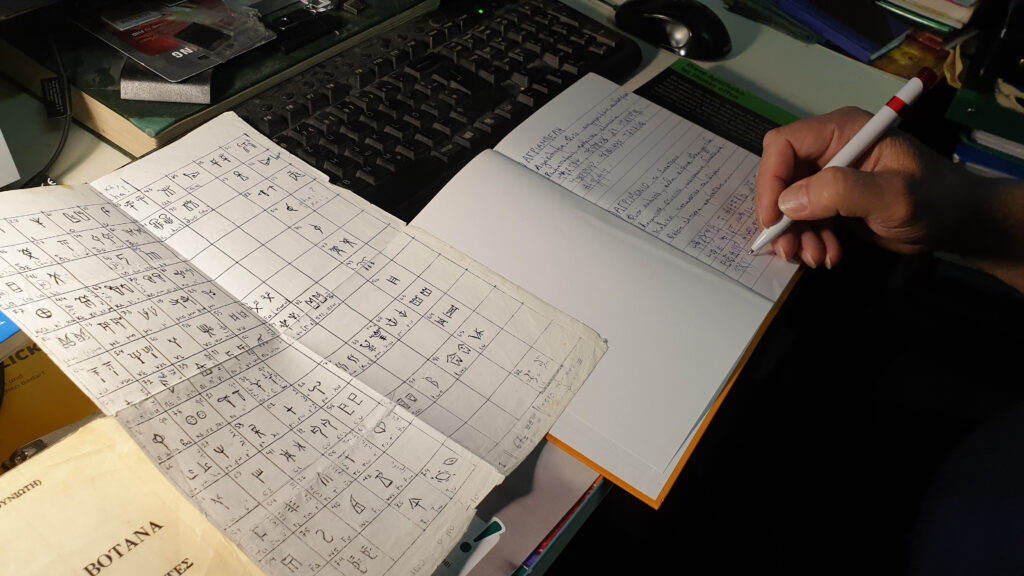by Nikos Samartzidis
edited by Garrett Bruner and Tom Palaima
Nikos is a painter and artist based in Rüsselsheim am Main, Germany. He renders modern and ancient Greek poetry and lyrics into Linear B and then onto paintings, clay tablets and other media. These works have been exhibited across Germany and Greece since the early 1990s, and more than twenty of his artworks hang on the walls at PASP. Find more on his website here.
καὶ τοὶ μὲν ναίουσιν ἀκηδέα θυμὸν ἔχοντες
ἐν μακάρων νήσοισι παρ᾽ Ὠκεανὸν βαθυδίνην,
ὄλβιοι ἥρωες, τοῖσιν μελιηδέα καρπὸν
τρὶς ἔτεος θάλλοντα φέρει ζείδωρος ἄρουρα.
“…And they live with a carefree heart on the Islands of the Blessed on the banks of the deep-swirling river Okeanos, blessed heroes that they are, and for them there is a honey-sweet harvest that comes to fruition three times each year, produced by the life-giving land…”
Hesiod: Works and Days Translated by Gregory Nagy
Always when I read such texts I think to myself: “What is it like to live under such conditions? Isn’t it boring? Not doing anything?” On the other hand, I have always considered artists, musicians, painters, poets, students, hermits and all those who live for their art, their interests and their personal values very fortunate.

This question has come to the surface again in the last months due to restrictions on the freedom of movement of citizens around the world. What can we do when we have to spend a lot of time indoors?
Fortunately, I did not have to find an answer to that question. My preoccupation with my latest artistic project concerning the connection of the Mycenaean syllabic script Linear-B with the Greek-speaking minorities of Southern Italy, did not leave me time to even think that something is changing. I spent endless hours reading song lyrics, listening to poets from Apulia and Calabria, watching videos about abandoned villages, villages and people hoping for a rebirth of their “Forgotten Language” called Grico or Grecanico.

I was informed about the great work carried out by scholars such as the German Professor Dr. Gerhard Rohlfs, the “Archeologist of words” and the Greek Anastásios Karanastásis. Both of them wrote dictionaries concerning this dialect. Since 2016 there is even a museum in Bova, dedicated to “the promotion and protection of the cultural heritage of the historical-linguistic minority of the Greeks of Calabria”.

(Greek-speaking towns and Villages in Calabria today: Amendolea, Bova, Bova Marina, Condofuri, Condofuri Marina, Gallicianò, Roccaforte del Greco, Roghudi, Roghudi Vecchio. In “Grecia Salentina”: Calimera, Carpignano Salentino, Castrignano dei Greci, Corigliano d’Otranto, Cutrofiano, Martano, Martignano, Melpignano, Soleto, Sternatia and Zollino).
And after collecting enough material, both in texts and audiovisual, I started painting. Previously, however, I had to do a lot of translation work. Because too many texts were not clear enough for me in the original. As a Greek, I could understand let’s say about 50%. To understand the rest I used existing Italian translations. So at the same time I started learning Italian by the Adult Education Centre of Rüsselsheim.

My studio – my “Insula Fortunata” – is located in “MALKASTEN” (“Paint Box”), ten minutes’ walk from my house. This is a local artists’ union that was established by a small group of painters and fans of art in Rüsselsheim right after the war in 1946. The visual artists’ section consists of an exclusive group of painters, graphic artists, photographers, sculptors and calligraphers. Membership is awarded after a thorough portfolio review. The group used to meet weekly to share wine and discuss art and philosophy. These meetings were very good for me and I learned so much from the older members – they were my best teachers. The club regularly organizes solo and group exhibitions. A well-known Rüsselsheim institution, the “Opel Villas”, frequently hosts art exhibits at international level. “Malkasten” organizes companion exhibitions that provide commentary to the main show and take place in the same venues.

In former times even excursions and small trips were planned to the south of France, Greece, Italy etc. In the history of the union there have been artists that have become well known in Germany. At least two of our members won the culture award of the town. The old members always have a story to tell about “the good old times” when they organized the carnival balls every year in the hotel “Adler” and painted the most successful posters for this. But there are young people as well, who look towards the future with hope and new ideas and prefer installations and concept-art.
In 1977 the club was enriched with a second section of all kinds of artisans such as potters, jewelry makers, woodcarvers etc. This gave a new dimension to the activities of the union. They started to organize an arts’ and crafts’ market twice a year in and around the 600-year-old fortress in town: one for Christmas and a big one in summer. They invite artists and artisans from all parts of Germany. It’s a real festival. Musicians play traditional music on old instruments. Nearly everybody wears a costume from old times and visitors have the feeling of being in a fantasy world.

In 1998 an art workshop for children was started. These weekly workshops try to awaken children’s natural curiosity and love for artistic creation.
For the time being there are about 40 members in the union and many guests that are always welcome. They visit “Malkasten” sometimes to exchange ideas, to try their abilities spontaneously or learn more in one of the many workshops. “Malkasten” also provides studio space to some of the members.

Here we should say a few things about our small city. Rüsselsheim, not far away from Frankfurt, is located on the Main river and is internationally known as home of the “OPEL” car manufacturer. The first cars of the company were built here in 1899. With a population of about 65,000 the city houses a branch of the Rhein Main University of Applied Sciences, a theater, a very modern municipal library, a hospital, event spaces, a stadium, a boathouse and many swimming pools. There are also many parks and forests in the surrounding area that make daily life very humane and enjoyable. A climbing park should of course also be mentioned; it is near a Bavarian beer garden. So when the weather is good and I feel like I want to take a short break from my work, I ride my bike and go on excursions in the surrounding forests and rivers or go hiking. This gives me a sense of freedom.
Back to my “Magna Graecia” project. This includes Artworks with Linear-B transcriptions inspired by Poems, Lyrics, Proverbs etc. of the „Grecanici”. The first approach includes about 30 paintings and more are added every week. The transcriptions were made directly from the original texts and not from the Modern-Greek translation. So, a “dying” language of Greek origins meets an ancient Greek “dead” script. I name here just a few of the poets of whom I transcribed a couple of verses, I hope the list will be even longer: Vito Domenico Palumbo, Domenicano Tondi, Franco Corlianò, Salvatore Tommasi, Brizio Montinaro, the brothers Salvatore and Agostino Siviglia, Salvino Nucera, Mimmo Nucera, Bruno Casile, Mastr’Angelo Maesano, Vincenzo Mesiani, Francesca Tripodi, Angela Campi Colella, Pippo Condemi.

I am very fond of and very happy about this project. I hear the songs from the Grico tradition with their irresistible beauty again and again. They have been famous in Greece as well for many years. However, that is not true for the poets. I find their language – the sound, the pronunciation, the accent – so familiar and sad, as if it comes out from the very heart of the past, a past of a bucolic, rural life in nature that will never return. One more “Island of the Blessed” lost forever? I would like to visit these villages some day, both in Salento and Calabria. Let’s hope my dream will come true. Now that I think about it, in my life I have always sought to find such mythical “blessed islands”.

Maybe all people do the same, each one in a way of their own. One of my first of these was Arvi, on the island of Crete. Later it was Horto, on Mount Pelion, near ancient Spalathra and ancient Olizon. My family too, is constantly one. Later this “Paint Box” was added. And what about a “Music Box”? I love music as well. Maybe more than painting. I believe these “blessed islands” are very near sometimes and tangible. We don’t have to look very far away. But what we need most of all for sure in order to find them is: to be free…



